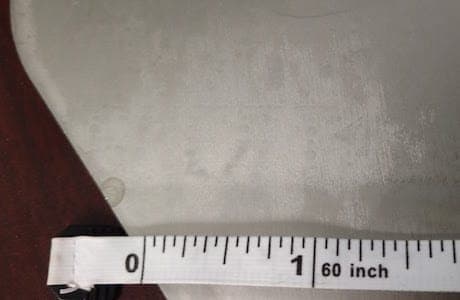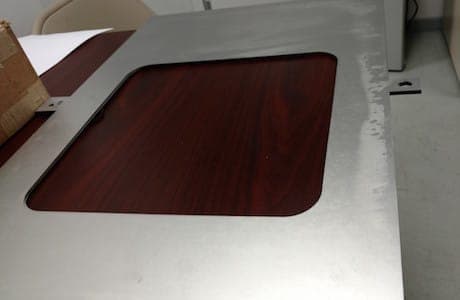
Curated with aloha by
Ted Mooney, P.E. RET

The authoritative public forum
for Metal Finishing 1989-2025

-----
White hazy finish after descaling Titanium
Q. I want to ask if anybody knows what etchants can I use for etching titanium after thermal oxidation? I want to see the titanium microstructure and the oxide coating. Now I am using 2% HF +2% HNO3 +96% H2O and oxide coatings are etched off or the microstructure is not visible. How long should I etching samples? Can anyone help me?
Krzysztof MendzikCzestochowa University of Technology - Czestochowa, Silesia, Poland
2005
A. I suggest you try straight 2% HF. Don't exceed 25 seconds. start etching from 10 seconds and find the optimal time by increasing the time you are etching for a second interval for every try.
Fatih Akdas1st. tech. uni. - Istanbul, Turkey
A. To get a look at the oxide layer, you probably are going to have to plate it with something like copper with little activation or cleaning. This will be rather non adherent, but it will be enough to protect the oxide layer. Dilute your etch by half and swab it on for a couple of seconds at a time. Rinse very well so the vapors do not attack your microscope. Repeat etch as many times as required. When you have your photomicrograph of the oxide, etch the Ti in the full strength as long as is required.
James Watts- Navarre, Florida
Multiple threads merged: please forgive chronology errors and repetition 🙂
Q. Hello,
I am responsible for the cleaning and descaling of Titanium Heat Treated (950 °F for 1 hour) parts. I am currently using an alkaline cleaner with a dechlorinated and DI water rinse prior to descaling. The same cleaning procedure is used prior to the heat treating process.
These parts are being descaled in a 20 - 25% Nitric acid/ 1.5% Hydrofluoric acid solution for a period of 1 - 5 min's, then rinsed in a dechlorinated city water bath (Continuous overflow)and then a final dechlorinated DI water spray rinse.
Sometimes we are seeing a white hazy blotchy finish and other times a uniform nice clean looking finish. The descaling purpose is to remove any free iron left on the parts due to the welding and heat treating process. I checked the white, hazy, blotchy, areas with a Koslow (Koslow Scientific Testing Instruments [a finishing.com supporting advertiser]) free iron tester and they are free of iron.
I am new to this type of process (Descaling & Passivation) and I want to make sure things are being done right.
Any suggestions or comments would be greatly appreciated.
Thank you !
Aerospace technician - Metal finishing - Ottawa, Ontario, Canada
March 21, 2008
A. Michael,
the cause of such foggy spots is due to slight damage from previous processes (or some iron remaining on the surface). If surface of titanium parts is uniform, the nitric + HF solution produces uniform clean surface. However if any cracks or uneven alloy structure, or else take place, then there is not enough nitric in local areas (nitric acid works as passivator), and hydrogen starts to damage the surface.
adv.
Our titanium etching gel or liquid electrolyte do not produce white or foggy areas on titanium surface, even if initial surface is not perfect.

Anna Berkovich
Russamer Lab
Pittsburgh, Pennsylvania

A. If I remember correctly, the nitric - HF ratio has to be more than 14:1, which if your tank goes low on the Nitric or high on the HF, then it will etch. As Anna said, if it is a rolled (rough) surface it can be attacked.
James Watts- Navarre, Florida
Q. Thank you for your replies.
I try to maintain a ratio of at least 16:1 Nitric/HF. However when I am making additions of HF to the bath, I am doing so because the descaling process is taking longer than usual due to the Hf being consumed (Correct me if I'm wrong). Or is it because the dissolved titanium in the bath is slowing the descaling process ? I make a new bath when the dissolved titanium reaches 10g/L.
I do not add Nitric when adding HF because my concentration level for Nitric is pretty consistent at 20 - 25%.
Should I be adding Nitric, when adding HF ?
Sincerely,
Metal Finishing - Ottawa, Ontario, Canada
A. Adding nitric would not be required as you add HF. I normally started with the weakest bath allowed by the OEM's and gradually increased the HF as it was used until I got to the max allowed. To keep the nitric-HF ratio proper, I had to add more nitric from time to time.
The problem is several fold. A bit of the HF is being used (tied up as a complex molecule) but you should be titrating for free fluoride and not total fluoride. The etch of the Ti is reduced by the formation of the complex IE: the more product that you form, the slower the reaction, regardless of concentration of the HF. There are equations for working this out, but it is a chapter in the chemistry book. Adding HF to the limit just allows you to get a bit more time out of the solution.
- Navarre, Florida
A. I do not know whether this comment will help but I use hydrogen peroxide to remove titanium oxide (and nitride) from titanium. The concentration can vary greatly. I control the pH to 7 - 9 using pyrophosphate as a pH buffer. In my case I have glass and other materials destroyed by nitric and hydrofluoric acids but even if I did not I would still prefer hydrogen peroxide. Dissolution of the oxide takes 1 - 24 hours. You can shorten the immersion time by heating and by raising the concentration of hydrogen peroxide. I usually leave my parts in the solution overnight cold. This process does nothing to brighten a dull surface; the titanium is not attacked at all.
Nick Clatworthy- Whitstable, Kent, UK
Q. I process similarly, however, parts are hot formed at ~1450°F. My bath has slightly higher nitric than is listed here. Could the exposure to temperature be uneven due to contact with dies, different die pressures in different areas, and one side of a sheet in contact with air versus the other side in contact with the bottom of the oven or die? If this is the case could the solution be treating the scale where it is thinner first, and yet require more time to treat the scale where it has formed thicker?


- Albany, New York, USA
July 21, 2017
Q, A, or Comment on THIS thread -or- Start a NEW Thread
